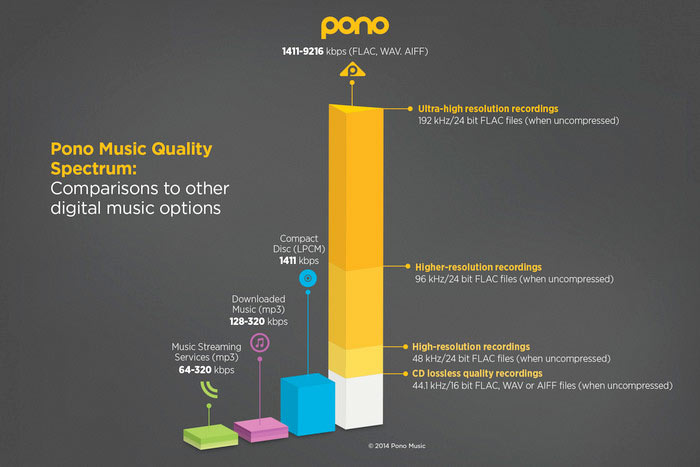The Low End of “Higher Fidelity”
The Pono Express just keeping on running. This morning they’re inching closer to the $5 million dollar mark with over 14,000 backers. The pace of new supporters signing up has slowed somewhat, at least compared to the opening flurry, but the Pono enterprise should have plenty of money to get their units manufactured and set up their music store.
There were a couple newsworthy items relating to Pono that I noticed since my last post on them. The first is a graphic entitled “Pono Music Quality Spectrum” that shows the relative merits of different music formats and delivery channels. I’ve included it in today’s post as figure 1 below (with full credit to Pono).
Figure 1 – Pono Music Quality Spectrum [Click to enlarge]
The 3D chart purports to show how Pono stacks up against “other digital music options”.
The various levels of music fidelity according to Pono are as follows:
1. CD lossless quality recordings – 44.1/16-bit PCM files encoded as FLAC, WAV or AIFF files (when uncompressed).
2. High-resolution recordings – 48 kHz/24-bit FLAC files (when uncompressed)
3. Higher-resolution recordings – 96 kHz/24-bit FLAC files (when uncompressed)
4. Ultra-high resolution recordings – 192 kHz/24-bit FLAC files (when uncompressed)
[NOTE: You might ask why the insistence on the accompanying “when uncompressed” parenthetical phrase at the end of each designation. This applies to the FLAC (Free Lossless Audio Codec) format downloads, which will dominate the Ponomusic site. The specifications listed only apply AFTER the file has been decoded…not to the packaged “losslessly compressed file”. There is some controversy among audiophiles about FLAC files sounding different than uncompressed .WAV or .AIFF files. I discussed this issue in a post several months ago (read more).]
It appears that the music that Pono customers will be able to access at the Ponomusic.com store will be at least Redbook or CD standard. I think the choice of “CD lossless quality recordings” is unfortunate because there is chance for misinterpretation. Sites the sell downloads aspire to CD fidelity and use “CD quality” in their wording to make customers think they’re getting Redbook standard when they’re not.
Just how much of the music that Ponomusic will offer will be at this level of fidelity remains unknown. From what I know of the existing transfers that have been done by the major labels…it’s not a lot. Is this really a format that will put the soul back into the music? Neil has railed against CD sound for decades…his Ponomusic site will has a lot of CD quality sound.
Their second tier is called “High-resolution” and pushes the sample rate to 48 kHz and increases the word length to 24-bits. I’m encouraged that this is their baseline for HRA. MY recent definition uses this as the minimum standard for HRA (I refer 96 kHz though). It remains to be seen just how much music is actually available at this level…and whether the tracks actually use the full 24-bits of dynamic range given the output from most mastering rooms.
The “Higher-resolution” category is where I fall out with Neil and Pono. Why have we switched from absolute standards with associated specifications and suddenly they introduce a relative term like “higher”. Isn’t this still “high-resolution” audio? Saying higher doesn’t get you anything. We need to avoid relative terms and stick with absolutes. The CEA used “higher” in their definition too…it’s doesn’t mean anything.
Then there’s the “Ultra-resolution” recordings at 192 kHz – 24bits. It makes me wonder what terms they’ll come up with for 384 kHz/32-bit recordings (oh yes, they’re coming…even though they’re meaningless!). I like “Super Ultra High Resolution”. What do you think?
The whole chart talks about delivery specifications. I’ll get back to you with a chart that ties the source side of the music produced in various formats to these categories.
Later…



Mark,
Please let me know when DPA produces a set of omni and card. capsules and amps that can capture the dynamic range possible at 384/32, that are somewhat affordable in matched pairs, and I’ll start working on modding some mic amps while waiting, and when it happens I will be in line right behind you.
The file size, even compressed will not be insignificant.
With the deep fissures in Net Neutrality, the providers might be counting their chickens with a smile.
I will…
Well, I do find the Pono roll out encouraging on many fronts; awareness, recognition that the starting point is 1411 Kbps and the fact that there are other bit rates in the “high(er) resolution” world. What will be interesting will be whether there is any information on the sources used to create the deliverable. I know that Neil’s equipment is analog – but I must say that his recordings sound great to me but that does not make them high resolution. In my opinion, what makes them great is the life of the recording – a lot of dynamic range (for this type of music), clean sounding, quiet and there is some space in the sound – not a wall of sound. I suspect that Neil is very involved in the mastering process and probably has the final say. I would be happier with a 1411 Kbps file with those characteristics than I would be with a high resolution file that has been squashed in the mastering process. My biggest complaint is that the mastering process is now a marketing decision rather than an artistic decision.
At first I was glad to see a bigshot popularizing something that’s been around for many years, but now I see that he’s really just spreading ignorance. Neil Young needs to spend some quality time reading up on how PCM works and why extending the sampling rate out to infinity does not equal higher resolution. He should start by reading all your previous posts here, Mark.
Pono = snake oil. There are already plenty of options for downloading true hi-rez music, music that was recorded, edited, and mastered at 44/24 or greater with no compression. If Neil Young lurrrvs the sound of vinyl, he can always round off the high treble, set his speaker size to “small,” set his subwoofer crossover at 40 Hz, and turn off his sub. There you go — now you’re in heavenly lo-fi vinyl bliss. There are even plug-ins available that add hiss, rumble, and snap-crackle-pop to your CDs so it’s like 1973 forever.
Neil is a rock star and the press are all over his “return to the soul of music” Pono story. But you’re right…this is not about high-resolution audio or even high quality audio…it’s about a new company that has raked in over 4.8 million dollars for something that is not better than what we already have…for less money. I’m going to write today on his misunderstanding of sample rates.
How to name 384/32?
I propose Double Ultra High resolution, or DUH! for short 🙂
Good one!
384/32…. How about “Unbelievable!”